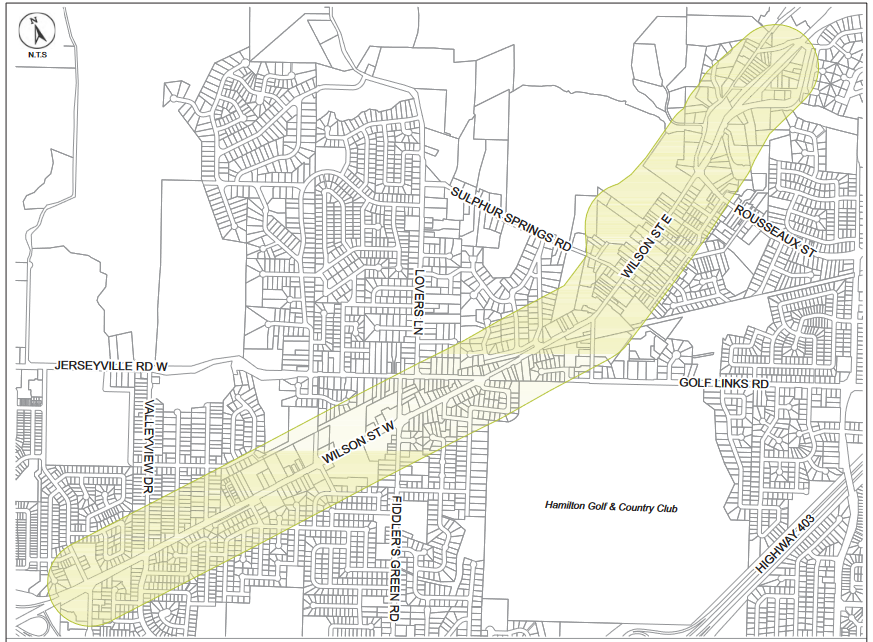Bob Maton of the Ancaster Village Heritage Committee, a resident organization, issued a statement this afternoon on behalf of the group responding to the Ontario Progressive Conservative government’s decision Friday to overturn the Ancaster low-density limit in Hamilton’s new Official Plan amendments.
Provincial Decision
In its decision posted Friday, the Province removed Ancaster’s exception from Hamilton’s city-wide community nodes planning policy.
Ancaster was exempted from the density requirements expected of nodes.
The city-wide policy for lands designated Mixed Use Medium
Density in Community Nodes is also amended to have a maximum permitted as-of-right height of six storeys.
New developments can build to eight stories if they meet height and design criteria. The City can impose standards such as an angular plane requirement.
Page 7 of the Province’s ruling [Provincial additions in Bold, removed portions in strikethough]:
32. Policy E.2.3.3.12 in Section 4.1.4 of Official Plan Amendment No. 167, Appendix D – Volume 1: Chapter E – Urban Systems and Designations is deleted and replaced so that it reads:
Notwithstanding any secondary plans, and notwithstanding policy B.1.2 of Volume 2, Chapter B of the Urban Hamilton Official Plan, lands designated Mixed Use Medium Density in Community Nodes shall contain a range of densities and buildings heights to a maximum of six storeys. Additional density above 150 units per hectare and additional height up to a total of eight storeys may be permitted without an amendment to this Plan, provided the applicant demonstrates:
a) there are no adverse shadow impacts created on existing residential uses within adjacent lands designated Neighbourhoods;
b) buildings are progressively stepped back from adjacent areas designated Neighbourhoods. The Zoning by-law may include an angular plane requirement to set out an appropriate transition and stepping back of heights; and,
c) buildings are stepped back from the street to minimize the height appearance from
the street, where necessary.”
“Notwithstanding Policy E.2.3.3.7, through the preparation of a Secondary plan, a lower density target for a Community Node may be established where the Secondary Plan process determines it is appropriate based on to the character of the adjacent Neighbourhood, other infrastructure, or transportation constraints as follows:
a) For the Ancaster Community Node, a target density in the range of 50 persons and jobs per hectare shall apply due to transportation constraints and the existing character of the adjacent neighbourhoods.
Page 13 of the Province’s ruling:
74. [New] Policy 2.8.6.1 g) is deleted from the Urban Hamilton Official Plan, Volume 2: Chapter B-2 –
Ancaster Secondary Plans as shown below:
g) The overall density for the Ancaster Community Node shall be 50 people and jobs per hectare.
Effect of the Provincial Decision
The effect of the decisions is to allow mid-density development with as-of-right zoning permissions. The decision does not restrict nor constrain the ability of the City of Hamilton to enforce heritage protections, design requirements, and other local zoning standards which follow the intent of provincial planning policy.
AHVC Statement
The following is the statement issued by Bob Maton on behalf of the AVHC:
“These are AVHC’s thoughts about the Ford government Ministerial Order which permits, as of right, development of up to 6 storeys and density of 150 units/hectare in Ancaster Village – or in some cases 8 storeys subject to a couple of conditions.
The Ancaster Wilson Street Secondary Plan design guidelines are still in place it appears, but how do you dress up 6 or 8 storeys to fit in to the Village heritage context?
Bottom Line: The Order to allow 6-8 storeys encourages the demolition of all structures in the Village Core, and ensures there can be no public process to try to stop that. If it proceeds, Ancaster Village, within a decade, will be 6- to 8- storey buildings. Period. And the Ministerial Order does not affect the rest of the Ancaster Wilson Street Secondary Plan, only the Village. Say what?
We can safely say that the Provincial Order is tailored to force through, against City policy, the 8-storey Manchia/Spallaci development at the corner of Academy and Wilson Streets, and secondarily the 7-storey development at Rousseaux and Wilson Streets. It now seems certain that the 1840 Marr-Phillipo House at that corner will be demolished.
These changes to the Ancaster Wilson Street Secondary Plan by Doug Ford ensure the destruction of every building in the Village Core. Ancaster history is being erased.
Over the next couple of weeks we will be working to confront this Order. ”
Production Details v. 1.0.0 Last edited: November 7, 2022 Author: Joey Coleman Edit Record v. 1.0.0 original version

